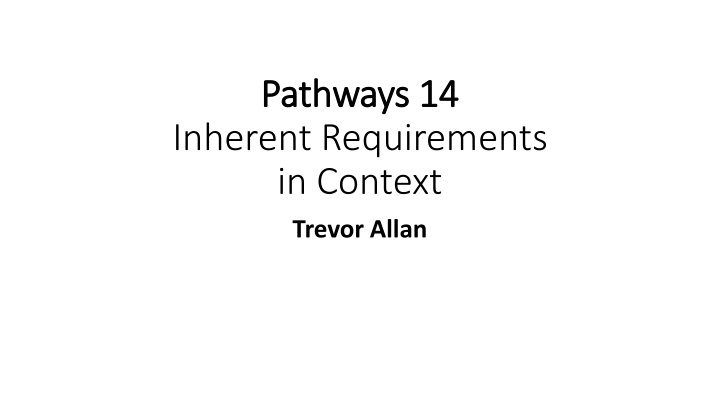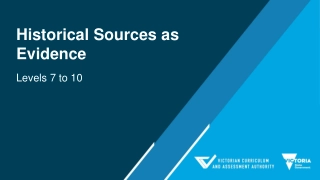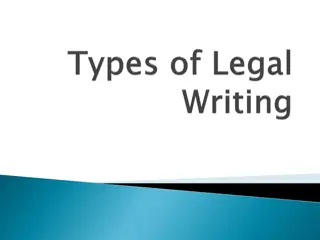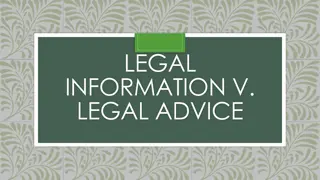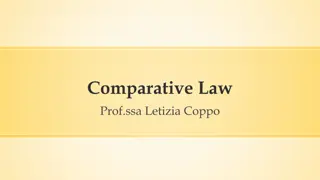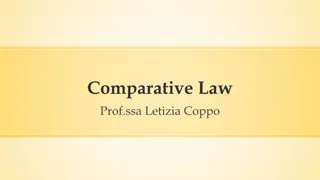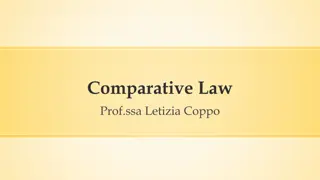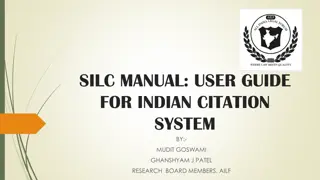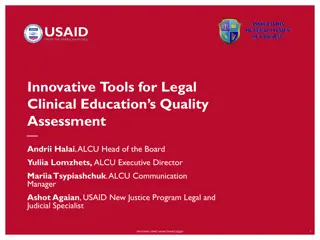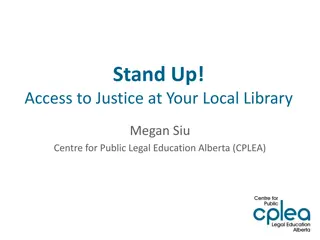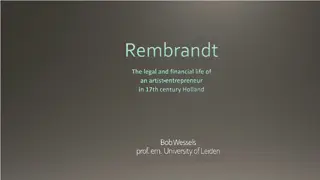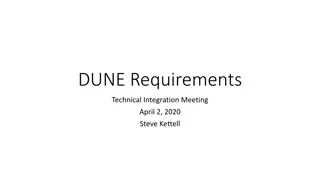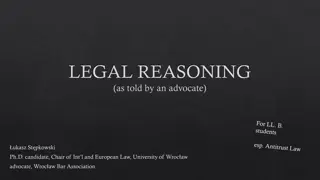Inherent Requirements in Context: Legal and Historical Overview
Providing insights into the legal context and historical development of inherent requirements in educational settings, this content discusses relevant legislation, including the Disability Discrimination Act and Disability Standards for Education. It explores the evolution of inherent requirements and their implications for accommodating students with disabilities or medical conditions.
Download Presentation

Please find below an Image/Link to download the presentation.
The content on the website is provided AS IS for your information and personal use only. It may not be sold, licensed, or shared on other websites without obtaining consent from the author.If you encounter any issues during the download, it is possible that the publisher has removed the file from their server.
You are allowed to download the files provided on this website for personal or commercial use, subject to the condition that they are used lawfully. All files are the property of their respective owners.
The content on the website is provided AS IS for your information and personal use only. It may not be sold, licensed, or shared on other websites without obtaining consent from the author.
E N D
Presentation Transcript
Pathways 14 Pathways 14 Inherent Requirements in Context Trevor Allan
Purpose: Place Inherent Requirements in context Legal Educational Historical Current/Future
History Inherent Requirements not new part of legislation from the start ANU 90s staff Information handbook and Training Cheryl Stickels and ors (WA) Guidelines and Procedures to assist Universities to Examine the Inherent Requirements of their Courses (When Accommodating Students with Disabilities and /or Medical Conditions) Cheryl Stickels Pathways 6 paper 2002 Mike Spurr UTAS School of Nursing
LEGAL CONTEXT LEGAL CONTEXT Most relevant legislation: Disability Discrimination Act (1992 as amended) Disability Standards for Education (2005)
How Legislation Works How Legislation Works Act passed by Parliament Once signed off by Governor General, and given a start date, they become law. Laws interpreted by courts (Case law, Precedent) Case law informs future cases, behaviours, etc. Courts interpret the law literally (e.g. Unjustifiable Hardship)
DDA Education Standards DDA Education Standards Very few disability discrimination cases go to court (c. 85% settled in Conciliation) Very little case law Conciliated settlements published on website Standards developed to assist in interpreting and implementing the DDA Subsidiary legislation Same force as DDA Compliance with Standards is compliance with DDA
DDA Education Standards DDA Education Standards Exceptions: Unjustifiable Hardship Acts Done under a Statutory Authority (e.g. Immigration Act) Protection of Public Health and Safety Special Measures Designed to Benefit a Student with a Disability (such as the provision of specialist disability services).
DDA Education Standards DDA Education Standards Section 3.4 (3) "in assessing whether an adjustment to the course, unit of the course or program in which the student is enrolled, or proposes to be enrolled, is reasonable, the provider is entitled to maintain the academic requirements of the course or program, and other requirements or components that are inherent in or essential to its nature. Note: in providing for students with disabilities, a provider may continue to ensure the integrity of its courses or programs and assessment requirements and processes, so that those on whom it confers an award can present themselves as having the appropriate knowledge, experience and expertise it implicit in the holding of that particular award.
Inherent Requirements example Canadian Exchange student Blind since birth Enrolled in in course 50% Film Study What is inherent? capacity to watch film and analyse or capacity to analyse abstract visual concepts?
Why Inherent Requirements? Why Inherent Requirements? Critical aspect of determining Reasonable Adjustments under the Disability Discrimination Act (DDA) and Disability Education Standards (The Standards) One of the few limitations on obligations to adjust for effects of a disability Integral part of the process of maintaining academic integrity Facilitates timely determination of adjustments as required by DDA Prevents indirect discrimination due to non-disclosure of information necessary for informed decision making about courses, enrolments, etc.
2009 Changes to DDA 2009 Changes to DDA Burden of Proof Obligation to Prevent Discrimination
External Registration and Accreditation Course Accreditation requirements may impact Inherent requirements must apply to all students Students must be able to meet course requirements, individual registration or employment separate issue
UWS IRONE Project UWS IRONE Project developed a structure and a process for identifying, developing and articulating Inherent Requirements for courses Valuable tool for developing reasonable adjustments Balance between access and academic integrity
Definition Definition Inherent Requirements are the fundamental components of a course or unit, that are essential to demonstrate the capabilities, knowledge and skills to achieve the core learning outcomes of the course or unit, while preserving the academic integrity of the university s learning, assessment and accreditation processes. (Note: making a requirement compulsory does not necessarily make it an Inherent Requirement.) Academic Senate Education Committee, 2010)
UWS IR Framework UWS IR Framework 5 Components: 1 Lead in /overarching statements 2 Descriptive statements i.e. a statement which describes the requirement 3 Inherent Requirement because (why/justification) 4 Characteristics of Adjustments 5 Exemplars
Why this approach? Why this approach? Previous approaches have simply stated requirements, without justifying inherency or considering adjustments Need to address the difference between compulsory and inherent requirements Lack of clarity can lead to discriminatory requirements and/or undermining academic integrity Need to consider whether adjustments are reasonable, consistent with Inherent Requirements
Principles: If you don t teach and assess it and apply to all students, it is not an inherent requirement. Personal attributes are not inherent requirements - students must demonstrate knowledge, skills and abilities For a requirement to be inherent, you need to be able to articulate why it is inherent or essential, and be prepared to defend it in court if necessary Making something compulsory does not make it inherent.
Some issues: Some issues: Need to ensure that we are articulating the Inherent requirements of Course not employment or registration Accreditation requirements may impact on some courses (e.g. MBA, NMBA, Law Society, etc.) may be inherent Students may be able to meet course requirements, but not register or practise profession, or may have qualified registration Significant Risk Management issue particularly after 2009 DDA amendments. Process of developing IRS is important Be careful not to confuse mechanisms for teaching and assessing with inherent requirements e.g. an exam is a mechanism for assessing the inherent requirement of demonstrating appropriate knowledge and skills, not the inherent requirement itself
Myths Developing Inherent Requirements gives students and educational institutions new rights and obligations Articulating IRs does not confer any new rights or obligations not present under existing legislation. All it does is clarify and articulate existing rights and obligations so that a critical factor in the process of determining reasonable adjustments is clearly understood. Inherent Requirements are designed to exclude students with disabilities from pursuing courses Experience has shown that having inherent requirements in place tends to be more inclusive that exclusive. Where students are genuinely unable to meet inherent requirements after exploring all possible strategies, then it is possible for them to be excluded, but there is a clear and validated rationale for this exclusion.
Current & Future developments: Current & Future developments: o Many universities developing IRs based on UWS model o Discussions and development of different IR models o Refinement of IR statements = dynamic, not static o Incorporation into Regulatory bodies & course accreditation (eg AHPRA) o Clearer, less contested process for determining Reasonable Adjustments o Academics more confident in accepting and approving Reasonable Adjustments o Students have a clearer understanding of what course requirements will be and be able to make more informed choices o Greater inclusion o Better protection for academic integrity.
Questions? Questions?
